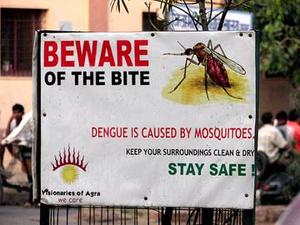EpidemicsU.S. unprepared for climate-induced disease outbreaks
Officials warn that the United States is not equipped to handle the spread of infectious diseases caused by climate change; little investment or progress has been made in bolstering disease detection and response capabilities in the United States, despite warnings from intelligence agencies; increased heat, humidity, and rainfall have caused the spread of mosquitoes and other bugs which carry deadly tropical diseases to new areas where people have yet build up a resistance; the United States is now experiencing outbreaks of dengue fever and West Nile virus; in 2010 the CDC reported 110 deaths and 1,356 cases of West Nile virus in the United States; intelligence agencies also worry about the potential for the spread of these diseases to destabilize fragile nations across Asia and Africa

The debilitating dengue fever is spread by mosquitoes // Source: athirady.info
Officials warn that the United States is not equipped to handle the spread of infectious diseases caused by climate change.
More than ten years ago, intelligence agencies warned that climate change would spread deadly infectious diseases to new regions. Yet, few advances have been made in bolstering U.S. disease detection and response capabilities.
Increased heat, humidity, and rainfall has been steadily driving mosquitoes, ticks, and other parasites to new areas resulting in the spread tropical and subtropical diseases to populations who have not yet built up resistance.
West Nile virus and dengue fever, once rare in the United States, have gained a foot hold once more. West Nile virus was first reintroduced in the United States in 1994 and has since spread to forty-four states, while dengue fever was spotted again in 2009 and is projected to spread to twenty-eight states, affecting more than 173.5 million Americans.
Last year the Center for Disease Control and Prevention (CDC) reported 110 deaths out of 1,356 cases of West Nile virus. Each year more cases and fatalities have been reported.
Officials say that, despite their repeated warnings, the United States is woefully underprepared to detect and respond to large disease outbreaks before they become national security threats.
“We’re way behind the ball on this,” said Josh Michaud, a former member of the Department of Defense’s National Center for Medical Intelligence and its Global Emerging Infections Surveillance and Response System.
According to Michaud, the U.S. disease monitoring system, which relies mainly on publicly available data and mathematical modeling, is insufficient to identify disease trends quickly.
Officials also worry that local health systems lack adequate epidemiological equipment and health technicians who are able to diagnose new diseases they have not seen before.
Howard Frumkin, the former director of the CDC’s National Center for Environmental Health said the U.S. ability to manage diseases spread by climate change was “shaky.”
The federal government has not sufficiently funded disease detection infrastructure projects and ignored pleas to address shortfalls in the system.
Joy M. Miller, the senior global health security adviser for the National Intelligence Council, specifically identified a “gap in our surveillance to even determine whether the vectors are changing and new diseases are being created and spread.”
Yet, instead of investing to remedy this situation, the White House has cut all funding
